When I was in grade school, my hometown team was the Kansas City Blues, the top farm team of the Yankees. In high school, my loyalty switched to the Kansas City A’s who had moved from Philadelphia in 1955. I still remember two special players who were on both the Blues and the A’s. One was Vic Power, a great first baseman with a good bat. The other was Bob Cerv who died last week at the age of 91.
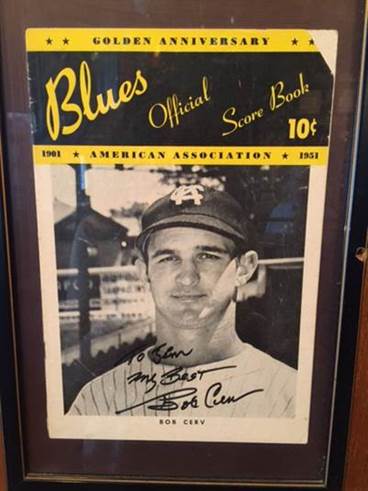
Cerv was in the U.S. Navy in WW II and then attended college in his home state of Nebraska. This delayed his entry into pro ball until he was 25. Cerv was signed by the Yankees in 1950 and played for the Blues for three years and then another three with New York. The Yankees then dealt him to the A’s in 1957. Cerv is most remembered for his 1958 season, the best ever played by a member of the Kansas City A’s. And he did it with his jaw wired shut for a month. He also had a couple of interesting connections to Mickey Mantle in 1951 and 1961. Here’s the story.
1951 – Kansas City Blues – Outfield Shuttle: I turned 10 in the summer of 1951 and followed Larry Ray’s broadcasts of the Kansas City Blues games. Blues fans appreciated that they often got to see budding stars who might someday be called up to the venerable Yankees. This also made us Yankee fans, and when Topps starting selling its bubblegum baseball cards in 1952, I did my best to assemble a full set of the Yankee cards.
In 1950, Cerv had played for the Blues while fellow Yankee farmhand Mickey Mantle played at a lower level at Joplin. In 1951, Mantle jumped to the major leagues while Cerv remained with the Blues. Mantle’s 1951 start for the Yankees went poorly, and he was sent to Kansas City to work on his batting stroke. Cerv was called up to the Yankees for part of the time Mantle was in KC. Another outfielder, Jackie Jensen, also became part of the shuttle between KC and NY. Mantle played 40 games in Kansas City before being called back up in August. Cerv was recalled to Kansas City after playing in 12 Yankee games (a “cup of coffee” in baseball talk). Jensen played 56 in NY and 42 in KC. Mantle and Cerv overlapped in KC long enough to be together in the Blues team photo (Mantle in the center, Cerv to his right).
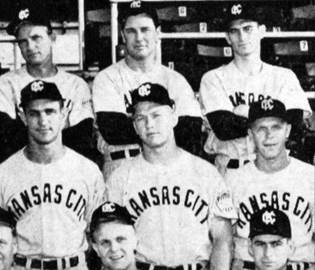
I told some of this story in Hot Stove #23, but now I will expand to connect the dots on the journey of Mickey’s iconic number. Mantle was assigned #6 as the Yankee season started in 1951. The Yankees had high hopes for Mantle and #6 put him in order to follow Ruth (#3), Gehrig (#4) and DiMaggio (#5). Cliff Mapes (a journeyman outfielder for the Yankees and former player for the Blues) started the season as #7. This photo shows Mapes wearing #7 and greeting Mantle crossing the plate after a home run:
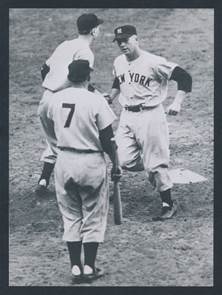
Mapes was traded in mid-season 1951 to the Browns, and his #7 went to Bob Cerv when he was called up from Kansas City. When Mantle came back to the Yankees in August, Cerv was on his way back to KC. Mantle’s #6 had been taken by another player, and so Mantle took what had been Cerv’s #7. No one else would ever wear #7, and the number is of course now retired in honor of Mantle.
1952 – Yankees Spring Training: The depth of the Yankee outfield in those days is reflected in this photo from 1952 spring training. Casey Stengel is shown talking to Archie Wilson, Bob Cerv, Gene Woodling, Mickey Mantle, Jackie Jensen and Hank Bauer.
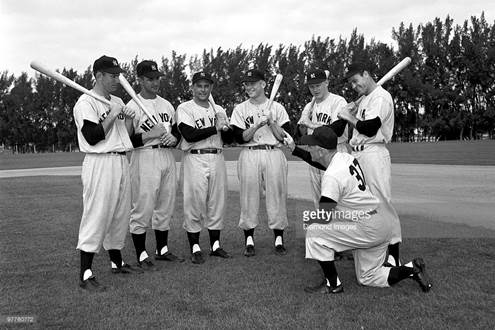
For the next few years, the primary outfield starters would be Mantle, Bauer, Woodling and Irv Noren. Jensen was traded to Washington in May of 1952 and then went to Boston for several years. Cerv finally made the Yankees for good in 1954, serving as a backup outfielder for three years before heading to the A’s in 1957.
1958 – Kansas City A’s – Jaw Wired Shut: Cerv had three good seasons with the A’s from 1957 to 1959, but it was 1958 that made him a hero in Kansas City. This was the summer between my junior and senior years in high school, and like any A’s fan from those days, I remember that Bob Cerv had a great season despite playing a month with his jaw wired shut. After news of his death last week, I heard from a few Hot Stove readers. Bill Carr: “Hit as I recall 38 home runs in 1958 and also broke his jaw. I was a big fan of his.” Pete Levi: “Jaw wired shut and kept playing.” Jim Chappell sent me the photo of the score book at the top of this post – the original is on the wall at Chappell’s Restaurant & Sports Museum in North Kansas City. Paul Donnelly told me about a Saturday Evening Post article where Cerv told his first-person story soon after the wires came out. The items in quotes below are from Cerv in the Post article.
As of May 17th, Cerv was tearing up the league. He was hitting .344 and led the league in homers (11) and RBI’s (30). The A’s were at home at Municipal Stadium for a Saturday night game. Cerv was on second base and attempted to score on a hit, “but as I approached the plate, I saw that [Detroit catcher Red] Wilson had me. I started to slide, then decided to crash into him, hoping I’d make him drop the ball. As we met, the left side of my face smashed against his shoulder.” Cerv’s jaw was broken, and it was wired shut so he could heal. He was told he would likely be out for six weeks. Not Bob Cerv.
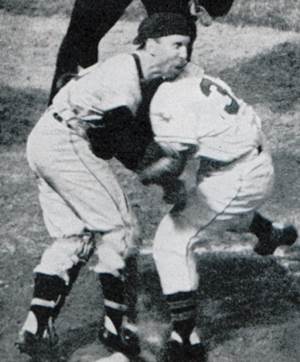
In less than a week, he was back in the game. It was not easy. “I couldn’t open my mouth. I had to live on a liquid diet. I couldn’t chew, talk clearly, breathe properly, cough, laugh, yawn or even sneeze like a human being.” Somebody had to be with him at all times, ready to cut the wires if he got sick or had breathing issues. The physical acts of hitting, throwing and sliding caused pain to his face and jaw. Breathing could be hard after exertion. In one game, after some long runs in the outfield for fly balls, he got back to the dugout and had to be revived with oxygen. Later that inning, “I belted one over the bullpen in center field.”
The grind was even worse on the road. He needed to room with someone who knew how to cut the wires in an emergency. He had to take his “blender, oxygen unit, vacuum bottles, flexible straws, portable electric water heater and vitamins and salt pills.” There were battles with room service to get the right kind of food for the blender. One time, he forgot to put the blender cap on and sprayed the hotel room with his dinner.
Cerv’s last wired games were in a Sunday double-header in Boston on June 15. He had a homer, three triples and two singles. The next day, the wires were removed. “My blender bender was over.” The ordeal had lasted for 28 games. His average had dropped to .310, but he still led the league in homers (17) and RBI’s (51). That means he had 6 homers and 21 RBI’s while wired up for those 28 games.
American League All Star Outfield and MVP Voting: In the 1958 All-Star Game, the starting outfielders for the American League were Mickey Mantle in center, Jackie Jensen in right and Bob Cerv in left – beating out Ted Williams. The three shuttle outfielders from the 1951 Kansas City Blues were reunited as all-stars. This recognition carried over to the end of the season in MVP balloting. Jackie Jensen was named MVP after finishing the season with 35 homers and 122 RBI’s. Mantle led the league in homers with 42. Cerv hit .305 and had 38 homers and 104 RBI’s. Cerv finished 4th in MVP voting and Mantle was 5th.
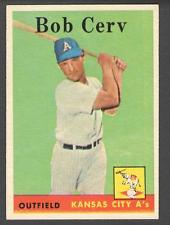
[A’s/Royals Trivia – The A’s played in Kansas City from 1955 to 1967. The Royals have played in KC since 1969. Cerv’s 38-homer season in 1958 remains the KC major league record. Steve Balboni of the Royals is next with 36 in 1985. The University of Nebraska has produced 16 baseball all-Americans. The first was Bob Cerv in 1950 and the most recent was Alex Gordon in 2005.]
Harry Truman and Bob Cerv: After high school, Cerv was in the Navy from 1943 to 1946. In 1944, he was on the USS Claxton in the Pacific when the ship was attacked by a Kamikaze plane. He was a loader on a gun mount and was reaching down for a missile when the plane hit. He luckily escaped injury, but five sailors were killed and 23 injured. When the ship returned after the war, it was ordered to Washington DC where the squadron got a Presidential Unit Citation. He met Harry Truman when the President came aboard to deliver the citation. When Cerv and Truman shook hands, they noted that they were fellow Midwesterners.
The two reconnected on Bob Cerv Night at Municipal Stadium on July 22, 1958. Cerv was showered with gifts from fans and citations from three governors who attended (MO, NE and KS). Former President Truman presented Cerv with an embossed copy of Cerv’s article from the Saturday Evening Post. Truman told Cerv he remembered him from the time they met on the ship in Washington. Truman asked Cerv if he ever got to Independence, and Cerv said “Yeah, I got kids going to school there.” Truman said “If you come by and don’t stop, I’ll have you picked up.” So Cerv would sometimes go by to visit Truman, spend a few minutes, then go pick up his kids.
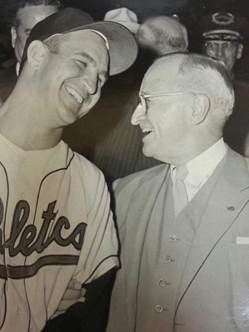
1960 – Return to the Yankees – Part 1: Many critics of the A’s thought the team was all but a farm team for the Yankees, just like the Blues had been. There were many questionable trades, often good young talent from the A’s being exchanged for aging stars of the Yankees. One of the most notorious was in December of 1959 when Roger Maris went to the Yankees. He was the MVP the very next year.
In May of 1960, a trade on a smaller scale between the two teams took place. Cerv returned to the Yankees in exchange for Andy Carey. Cerv and Maris were friends from their time with the A’s and they also lived in KC in the offseason. Maris had rented an apartment for $251/month in Queens and Cerv moved in. Maris finished with his MVP season and Cerv had modest results in 87 games. Cerv had a good World Series, going 5 for 14 for a .357 average, but the Yankees lost on Mazeroski’s walk-off homer.
1961 – Return to the Yankees – Part 2: The American League expanded for the first time in 1961. Cerv was left unprotected by the Yankees and was drafted by the Angels. He started in left field on opening day, but the Yankees apparently missed him and reacquired him in a trade in May. Cerv moved back in with Maris, and that summer, they picked up another roommate: Mickey Mantle. With only two bedrooms, Maris reportedly slept on a green sofa. This was of course the year when Maris and Mantle were both on a pace to break Babe Ruth’s season record of 60 homers. The apartment was a quiet place to keep away from the press.
I consulted Jane Leavy’s remarkable Mantle biography (The Last Boy) to get details on the apartment life. Mickey had been staying at the St. Moritz Hotel and his carousing was getting him into trouble. It was suggested to Mantle that he get away from Manhattan by moving in with Maris and Cerv. Mickey objected at first, “I’m not going to go out to God’s world.” Leavy interviewed Cerv for her book and his account was that he was “skeptical about it…I knew what he did.” Roger said “Oh, hell, let him come.” Cerv agreed, but had rules. “If you break them you’re outta here – no partying, no girls.” Mickey said “I’d like to have a summer like that.” Cerv said Mantle played by the house rules most of the summer, but once “brought a gal up there. We ran ‘em both out and pretty soon, about a couple of weeks later, that’s when he left. Labor Day, he said he had enough of this life. Went back to Times Square.”
Maris hit 61 homers to break Ruth’s record and was again named MVP. Mantle was injured and faded to 54 homers. Cerv had only 131 plate appearances for the season, but he did end up sharing a record (well, in my record book): Most homers by roommates in a season – 121. Cerv had 6 of these.
In 2001, Cerv got screen time in Billy Crystal’s HBO movie “61*” (he was played by actor Chris Bauer). The film incorrectly shows Cerv in the Yankee opening day lineup in 1961 – as noted above, he started the season with the Angels.
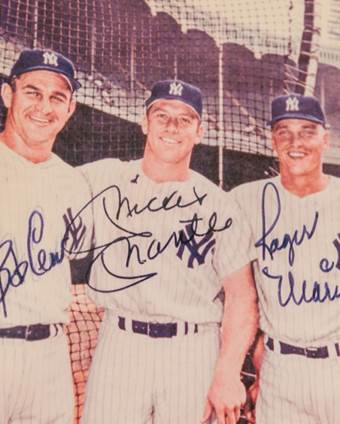
1951 Shuttle Outfield – Retirement: Cerv did not play in the 1961 World Series because of a knee injury. After starting the 1962 season with the Yankees, he was sold to the expansion Houston Colt 45’s. He retired in July at age 37. Jackie Jensen retired after the 1959 season because of his fear of flying. After missing 1960, he tried hypnotherapy to reduce his fear, but his comeback season in 1961 was subpar and he retired for good. Mantle continued with his Hall of Fame career until his retirement in 1968. Roommate Roger Maris stayed with the Yankees through 1966 and then had two final years with the Cardinals. Maris turned out to be a one-hit wonder for big home run seasons. Other than his 61 in 1961, he never had more than 39 in a season.
Music Note – Rosie and the Originals: During the offseason between 1960 and 1961, there was a song on the charts that many of you likely recognize: “Angel Baby” by Rosie and the Originals. It was a one-hit wonder that Rosie Hamlin wrote and recorded when she was 15. I was in college at the time and no longer buying 45-rpm singles at the rate I had in high school. But this is one I bought and still have. Rosie died on March 31 at age 71.
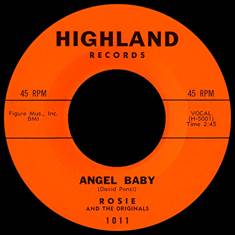
John Lennon was a big fan of the record and covered the song on one of his albums with this introduction: “This here is one of my all-time favorite songs. Send my love to Rosie wherever she may be.” But Rosie sings it best: (click here, 3:34).